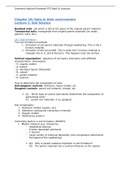Summary Natural Processes PT2 Book & Lectures
Chapter 18: Soils in their environment
Lecture 1: Soil Science
Residual soils: soil which is still at the place of the original parent material.
Transported soils: transported from original parent materials (by water,
glaciers, wind, etc.)
18.1 Soil formation
Two soil formation processes
1. formation of soil parent materials through weathering. This is the C
horizon material.
2. formation of the soil profile. This is when the C horizon material is
changed into A, E, and B horizons. This happens near the surface.
Vertical organisation: sequence of soil layers (horizons) with different
characteristics. Downwards:
- O: organic matter
- A: topsoil
- E: eluviated topsoil (bleached)
- B: subsoil
- C: parent material
- R: bedrock
How to determine the composition of soils
Antropogenic controls: fertilizers, heavy metals, etc.
Geogenic controls: parent soil material, climate, etc.
Q1: Which type of control dominantly determines the composition of
agricultural soils?
A1: parent soil materials so, geogenic
Soil components:
1. Resistant residue (quarts, etc)
2. Alteration compounds (secondary minerals)
3. Organic matter
4. Weathering solution
Controlling factors in soil formation (PClORT):
Parent material (e.g. limestone)
- Weathered bedrock
- Freshly deposited sediments
- C horizon
- Large variety of chemical deposition (this composition determines
the speed of the weathering)
Q2: Why is parent material important in soil formation?
A2: The parent material has a vertical influence on the topsoil.
,Summary Natural Processes PT2 Book & Lectures
Climate
- Temperature is very important (high temp, high activity /
weathering / amount of water)
- Precipitation
o Precipitation > evaporation: leaching, peat formation
o Precipitation < evaporation: e.g salt accumulation
- Soil water balance (precipitation)
o tropical soils: intense weathering, low organic matter
(because it decomposes really quickly)
o desert: little leaching, low organic matter
o steppe: high organic matter, high leaching
o taiga (naaldwouden/boreal forest): slow decomposition, high
organic matter, high leaching
- climate determines growth rates and decomposition
Q3: Why is climate an important factor in soil formation?
A3: Climate governs the amount of CO2, the amount of
precipitation and temperature (determining weathering). Climate is
the most important factor in soil formation.
Biota (organisms)
- Flora
o The main source of organic material
o Plants enhance consolidation, the compaction of clay, which
influences the hydrology
- Fauna
o Organisms and plants can move/transfer soils etc and
determine structure. Moles, worms, roots, etc.
o Humans also influence soil with agriculture
Q4: why are the biota important in soil formation?
A4: Important for the mixing of the soils, getting minerals
everywhere, mixing, etc. (?)
Topography (relief)
- Slopes influence the water content of the soil
- Influences erosion and transport of materials
Q5: Why is topography important for soil formation?
A5: Transfer of materials and water distribution which also
influences the decomposition etc.
Time
- Whether or not the soil is disturbed
- Soil processes take time – ‘new’ soils (azonal) have yet to develop,
while older soils have clear horizons
Zonality:
Zonal soils: typical for certain climate
Azonal soil: younger, not yet in balance
Intrazonal soils: climate is not the determining factor (e.g. parent material, salt
etc)
, Summary Natural Processes PT2 Book & Lectures
Lecture 2: Soil formation
18.2 Processes of soil formation (pedogenic processes)
Important groups for soil formation processes:
- Additions (inputs)
o Weathering of parent material
Unloading (remove pressure from top layer, stone expands
and breaks)
Thermoclasty (expanding and shrinking of rocks bc of
temperature changes)
Gelicfraction (by ice)
Halofraction (volume changes bc of salt)
o Sedimentation
o Atmospheric depositions (wind etc)
o Anthropogenic influences
o Litterfall
- Losses (outputs)
o Erosion
o Leaching
Leaching: continuously washing the soil with rain water.
Well leached soils have a lower pH.
In solution (nitrate)
In suspension (clay)
Decalcification: removal of free calcium carbonate by
leaching. Leads to lower pH.
Calcifiation: In arid regions, bases will be washed
downwards during rainfall but moved up by capillary
movement in dry periods. Causes the accumulation of
calcium and other bases.
Podzolisation: pale (bleached) horizon between eluviated
(washed out) and illuviated (washed in) soil. Due to extreme
leaching of fulvic acids (litter). Temperate climates.
- Transformations (internal change)
o Chemical weathering
Acid dissolution, chalk dissolution, etc.
o Organic material (decomposition, mineralisation)
o Redox processes (high ground water levels)
Redox is the exchange of electrons.;
+ is oxidation
- is reduction
Aerobic, is O2 the e- acceptor
Anaerobic is e.g. NO3- e- acceptor
Gleying: when a soil is filled with water. Driven by seasonal
soil water differences. Colour changes: reddish/iron,
grey/manganese etc.
o Soil maturation (change of fresh soil to older soils)
Physical (soil dries out, etc)
Chemical (oxidation>reduction, dehydration, etc)





